Experts with the United States Geological Survey (USGS) announce that the conclusions of their latest study support in part the idea that the survival of a population of endangered shorebird species is dependent on the number of horseshoe crabs living inside the same ecosystem.
The shorebird species is called red knot, and is endangered according to the latest classifications. There are only a few exemplars of this species left, when compared to numbers historical sources indicate.
Details of the research effort appear in the latest issue of Ecosphere, a scientific journal edited by the Ecological Society of America. Speculations that the two species were closely connected have been made in the past, but few evidences have been brought to support these claims over the years.
Over the past 15 years or so, the red knot population has declined considerably, and experts are having a hard time figuring out the exact cause. What the new study shows is that the number of egg-laying horseshoe crabs in the Delaware Bay area has something to do with this.
“This is one of the first studies to scientifically support the ecological links between these two species,” explains the leader author of the new study, Conor McGowan. He is also a scientist at the USGS.
At this point, the horseshoe crabs are exploited without any regard for the sustainability of this practice. The pharmaceutical industry is one of the main consumers, as it collects the creatures' blood for its amazing clotting properties.
Fishermen also use the crabs as bait to catch bigger oceanic animals. By conserving the number of horseshoe crabs and eggs they deposit, authorities might help save not one, but two endangered species.
“Our research strongly suggests that the timing of horseshoe crab spawning, not simply crab abundance, is important to red knot refueling during their stops in Delaware Bay,” McGowan explains.
The investigation spanned more than 12 years. During this time, more than 16,000 red knots were analyzed, as researchers wanted to gather as much data on the animals as possible. After arriving at Delaware Bay, the bird need to gain weight as soon as possible, the team found.
This is impossible if only small numbers of horseshoe crabs hatch during that time. A red knot with a low body weight has a much higher chance of dying than one which manages to grow in body mass.
“If the timing of migration and the availability of food resources – in this case, horseshoe crab eggs – do not coincide, migrating shorebirds, such as the red knot, that come to Delaware Bay each spring, could be adversely affected, both individually and as a population,” McGowan adds.

 14 DAY TRIAL //
14 DAY TRIAL //